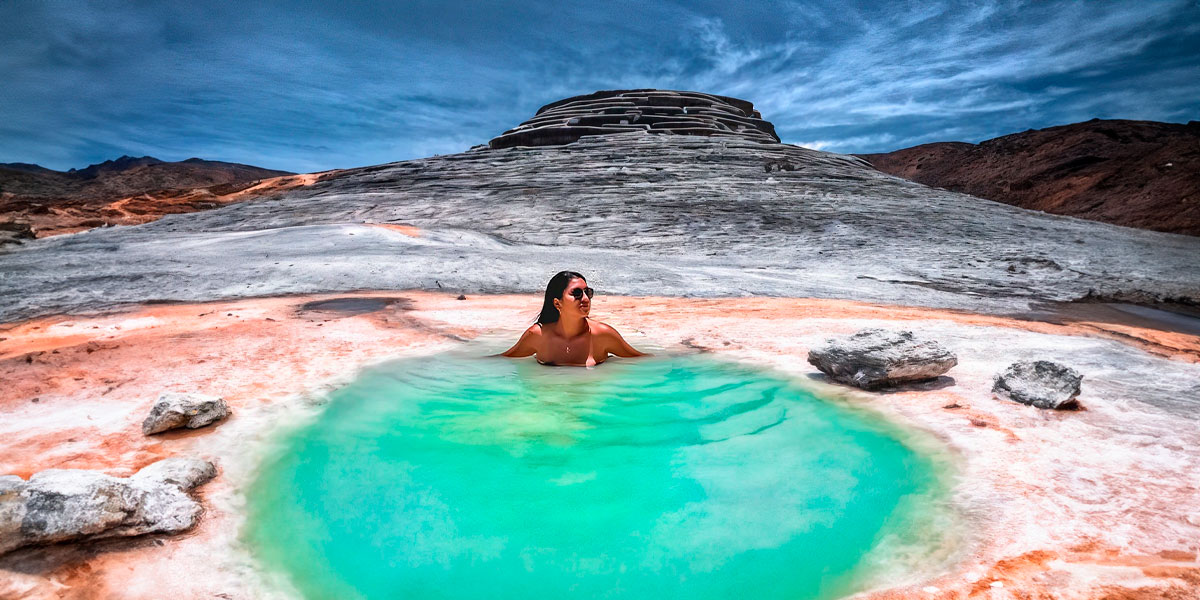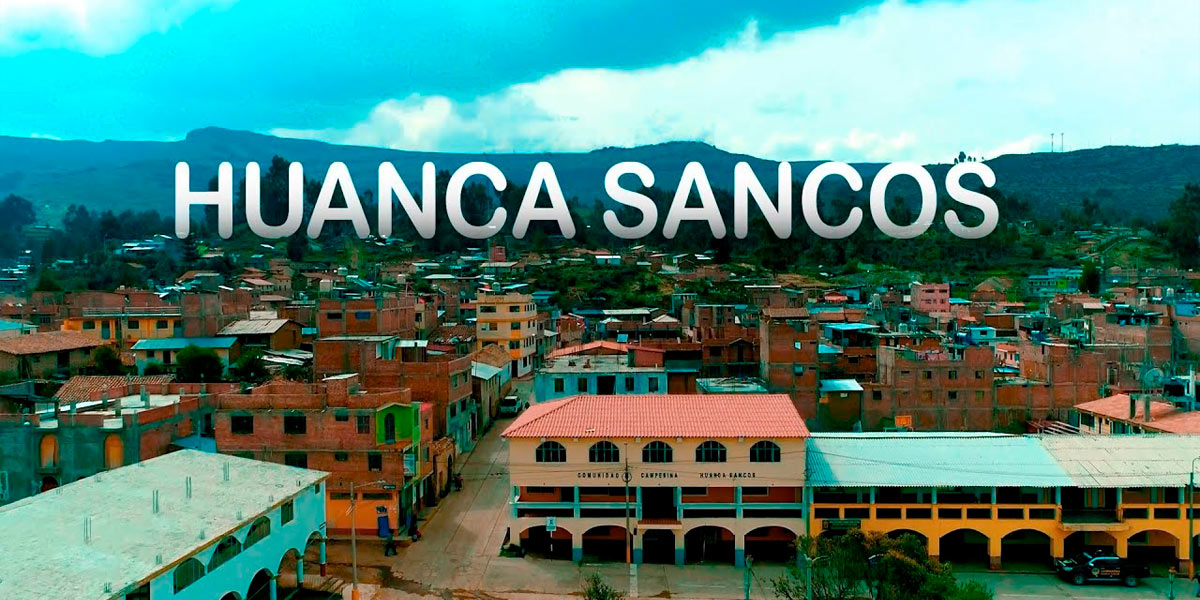The PachaPupum Hot Springs are a thermo-medicinal resource, which is located in the Sacsamarca district, in the Huanca Sancos province, in the Ayacucho region.
Pacha-Pupum, means "navel of the earth", and is also the name of an extinct volcano, located in the area, and from which the waters that nourish the resort hot springs. The Pacha Pupum hot springs are rich in the presence of sulfur, which is why they are recommended for people suffering from nervous and skin diseases.
The resource is located 35 kilometers from the Plaza de Huanca Sancos, admission to it is free, but it is recommended that visits be made between the hours of 6 in the morning and 5 in the afternoon. There are combis that can take those interested to the same hot springs.
Location
Located in the department of Ayacucho, province of Huanca Sancos, Sacsamarca district, within the natural sites category, of the type thermo-mineral water, subtype thermal waters, with hierarchy 1, at an altitude of 4022 meters above sea level, annex of Ccontacc.
The Pachapupum Volcano
The Pachapupum Volcano is located in the Huanca Sancos Province, located at an altitude of 4,022 meters above sea level in the Sacsamarca District.
It is a natural stone monument formed by the fall of salt and sulfur components in the shape of a cone. It has an approximate height of 30mts.
The access to the upper part is by some stairs, the same ones that are formed naturally, where an opening of 8 to 10 mst can be seen. in diameter, at the bottom the presence of water in a state of permanent boiling can be observed. Around this monument there are small rustic wells of medicinal thermo-mineral waters that emanate a penetrating smell of sulfur. According to the residents, its waters have multiple healing properties.
-
What does Pacapupum mean?
The Pachapupum volcano, also known as "El Volcán Dormido", is a natural wonder that is located in the province of Huancasancos in the Ayacucho region. It is surrounded by volcanic stones and lagoons with hot springs in various forms. -
When to visit the Pachapupum Volcano?
The best time to visit this place is from April, and the cost of a full day tour can be between 120 to 150 soles. -
Pachapupum Hot Springs
Located at 4020 meters above sea level, its waters have healing properties for asthma, arthritis and skin diseases, among others. It has a temperature of 45ºC (113ºF) and a strong smell of sulfur. It is located 35 km south of the city of Sancos, by unpaved road. (45 minutes by van).
The Pacha-Pupum Hot Springs are a thermo-medicinal resource, which is located in the Sacsamarca district, in the Huanca Sancos province, in the Ayacucho region.
Pupum, means "navel of the earth", and is also the name from an extinct volcano, located in the area, and from which the waters that nourish the resort's hot springs emanate. The Pacha Pupum hot springs are rich in the presence of sulfur, so they are recommended for people who suffer from nervous and skin diseases. The resource is located 35 kilometers from the Huanca Sancos square, admission to it is free, but It is recommended that the visits take place between the hours of 6 in the morning and 5 in the afternoon. There are combis that can take those interested to the same hot springs.
“View of the city of Huanca Sancos”
The province of Huanca Sancos is in the department and region of Ayacucho and has a territorial area of 2,862.33 km². Its capital is the city of Sancos, located in the center of the region. The province stands out mainly for its livestock activity, but also for the richness of its natural landscapes and tourist destinations that reflect the history and tradition of the area.
Huanca Sancos is recognized as the “Navel of the Chanka culture”, since it is located within the territory where the Chanka Confederation settled, belonging to the Late Intermediate period, after the influence of the Wari culture. The Chankas played a key role in the history of pre-Hispanic Peru, known as a warrior people who firmly defended their territories. However, in the mid-1400s A.D., the Incas arrived in the area and, after a series of clashes, managed to subdue the Chankas, incorporating their territory into the Tawantinsuyo.
With the arrival of the Spanish in the 16th century, the history of the province changed radically. In 1570, the Village of Nuestra Señora de la “O” de Sancos was founded, which would mark the beginning of the colonization of the area. Later, during the Republic, Huanca Sancos was created as a district in 1826. Its growth was constant, and in 1957 it became the capital of the district of Sancos. Finally, on November 20, 1984, it obtained official recognition as a province of the Ayacucho region.
Today, Huanca Sancos not only keeps its historical importance, but it is also a place of interest for those who want to know the cultural heritage of the Chankas and enjoy little-explored natural landscapes.
Historical review
The beginnings of primitive life in this territory were difficult and marked by constant challenges. However, oral traditions and local legends hold that its first inhabitants descended from the Huancas y Waris, ancient peoples who settled in Ñaupa Llacta, whose best-known archaeological remains are "Ayaya Mocco". With the arrival of the Spaniards and the policy of reducing indigenous peoples ordered by King Philip II, Viceroy Toledo, along with his commissioner Juan Palomares, ordered the transfer of all inhabitants to a new settlement. Thus, on December 18, 1573, the Town of the Virgen de “O” de Sancos was founded, under her patronage. According to the chronicler Felipe Huamán Poma de Ayala, in its early years it was also known as "Zanco-Huanca".
Over time, this settlement gained more relevance. During the republican stage, by order of Simón Bolívar, in 1825 it went from being a simple annex to the category of district. Later, under the government of Ramón Castilla, on January 2, 1857, the district of Sancos was officially created, with its capital in Huanca Sancos, initially belonging to the province of Cangallo. Later, with Law No. 1306 of November 14, 1910, it became part of the new province of Víctor Fajardo.
In the cultural, economic, and social spheres, Huanca Sancos experienced a period of remarkable development for 74 years, which allowed it to rise from the category of a town to a city through Regional Law No. 340, enacted on September 6, 1920, at the request of the regional deputy Dr. Cirilo Moscozo.
Finally, on September 20, 1984, through Law No. 23928, enacted by the then constitutional president of the Republic, Fernando Belaunde Terry, Huanca Sancos was elevated to the category of a province of Ayacucho, made up of four districts: Sancos, Carapo, Sacsamarca y Santiago de Lucanamarca, with its capital in the city of Huanca Sancos.
Tourism in Huanca Sancos
The province of Huanca Sancos is located in the department and region of Ayacucho. Huanca Sancos has a territorial extension of 2,862.33 Km2. This presents as capital the homonymous city. Huanca Sancos is also considered "The navel of the Chanka culture", since it is located within part of the territory where the Chanka Confederation settled.
Although the Chankas played an important role in the territory, later, in the middle of 1400 AD, the Inca hosts arrived in the area and, after several confrontations, managed to subdue the warrior people. Later the Spaniards would arrive in the area, founding, in 1570, what would then be the Pueblo de Nuestra Señora de la “O” de Sancos. Years later, during the Republic, Huanca Sancos is created as a district, in 1826; Later, in 1957, this city became the capital of the Sancos district until finally, on November 20, 1984, it was recently declared the province of Ayacucho, with the name it currently has.
Huanca Sancos has interesting tourist attractions, such is the case of places such as:
- Ituni – Also known as “Chicken Warkuna”. These are some archaeological remains in which the presence of 200 chullpas or funerary spaces can be observed.
- Ñaupa Llanta – This is also known by the name of Carapo. They are archaeological sites of pre-Inca origin. It is also known as Ñaupallaqta Carapo.
- Silvanan – This is a beautiful setting that is located on the banks of the Tarunca River. In this you can see some windows that are limiting with a precipice; there are also burials that possibly include the bodies of Chanka warriors.
In the province there are also places for the practice of thermo-medicinal tourism, such is the case of the Thermal Baths of Sucho and Rosasniyoq in the district of Sancos.
For people who want to get to know this province and interact with people during its festive season, it is recommended that they visit Huanca Sancos during dates such as: carnivals; or religious festivities such as the feast of the Apostle Santiago and Felipe, during July, which is also known for being a ceremony where water is worshiped, thus mixing indigenous and Christian rituals; and the most important, the Feast of the Virgin of the "O", patron saint of the province, whose celebration takes place from December 8 to 18 of the same month.
Best Tours in Peru
Many are the routes that take you to Machu Picchu, but none is like the Inca Trail Tours, the most famous pedestrian path in the Americas. After flying from the capital of Perú, Lima, you will arrive in Cusco to walk for four days along a path through forests and dense fog, millenary stone steps and discovering the ruins of ancient fortifications and Inca cities, and all the time enjoying majestic views.
- Peru Adventure Holidays
- Enigmatic Peru
- Peru Full of Adventures
- Peru Luxury Travel
- Peruvian Highlands
- Discover Peru
Inca Trail, Machu Picchu and more
- Salcantay Trek Peru to Machu Picchu 5 days
- Palcoyo Mountain Tour
- Cusco to Manu Tour
- Humantay Lake Day Trip
- Huchuy Qosqo Day Hike
- Llactapata Inca Trail to Machu Picchu
- Apurimac River Rafting
- Vilcabamba Trek to Machu Picchu
- Inti Raymi and Machu Picchu Tour
If you want to visit Machu Picchu, we recommend you to book your Machu Picchu Ticket in advance, so you will enjoy your Vacation in Machu Picchu without any problem.








